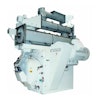
Through many conversation with feed mill and agribusiness managers across the U.S., I’ve come to realize how valuable an ERP (enterprise resource planning) system can be. Every day, feed and grain businesses perform countless functions ranging from inventory management, order fulfillment and ingredient purchasing to manufacturing operations, payroll and accounting.
Having multiple locations that rely on a combination of manual (paper) systems and software or cloud-based systems can compound the complexity of agribusiness management, which can result in outdated procedures and inefficiencies.
An ERP system uses technology to automate and link all business functions, streamline efficiencies and simplify data access and analysis across locations and divisions.
According to expert Stephen Berry, vice president of information technology and data security for the Cultura Portfolio, there is no “one size fits all” ERP solution, especially in the agrifood sector, but there is a right-size ERP strategy for every business.
One strategy is a monolithic ERP — a unified system that integrates all business processes into one — developed by a single software vendor. This strategy involves the migration of all company data into the system and requires interfaces with each program the company uses so all employees, from facility operators to accounting and HR, use the same tool to perform their roles. Implementing an ERP system like this can be an expensive, data-intensive endeavor, and may lack the level of customization required for grain processing and feed manufacturing operations controls. But it may be a fit for large businesses with the budget this strategy requires and where the benefits of a streamlined system outweigh the need for flexibility.
For most feed and grain companies, the appropriate ERP strategy is postmodern ERP, which focuses on two categories: administrative and operational. The administrative ERP system focuses primarily on financials, human resources and indirect procurement. The operational side of an ERP maximizes efficiencies into areas such as order management, manufacturing and supply chain.
Software integration is key to a postmodern ERP strategy and does not mandate the use of a single platform or tool. Berry described postmodern ERP as a strategic approach that recognizes every agribusiness is unique and must formulate a strategy based on those specific needs with various tools. The goal is to use technology to align people and processes to enhance communication, increase data access and empower decision-makers.
ERP integrations specialized for agribusiness
The availability of ERP software integrations tailored for agribusinesses has dramatically increased during the past decade. For example, in 2022, ERP software provider Bushel integrated with EFC Systems’ Merchant Ag ERP software, allowing agribusinesses to provide real-time business information through digital tools, including Bushel’s mobile app and web. This flexibility enables users to access essential data and make informed decisions from various devices and locations.
The partnership helps strengthen relationships between agribusinesses and grain growers, saves time on clerical conversations, and redirects communication toward improving grain marketing and other strategic business initiatives. Bushel has integrated its platform with other ERP partners like Rain and Hail to enhance customer data reports and link information from scale tickets, contracts and settlements to insurance systems. It also began a partnership with Roger in 2020 to offer digital tools for shippers and carriers of dry bulk truck freight.
Another example is risk management firm Hrvyst joining forces with Greenstone Systems, a Cultura Co., to enhance data accessibility by integrating its cash bids and futures pricing into Greenstone's grower engagement platform MyGrower.
The integration enhances the digital experience for grain elevators with real-time access to relevant basis, futures and cash prices in addition to information such as tickets, contracts and settlements. This comprehensive data access streamlines operations and provides a central platform for interactions with producer customers.
The integration between GlobalVetLINK (GVL) and Micro Technologies is one example that benefits livestock producers by offering a seamless solution to track and manage feed-grade veterinary feed directives (VFDs). It enhances compliance with U.S. Food and Drug Administration (FDA) regulatory requirements by allowing cattle producers to track their feed inventory, prescribed dosages and the number of animals involved all through the integrated platform. Digitizing this process saves producers time, aids with traceability and reduces the administrative burden of manually tracking such activities.
Each of these examples enables businesses to become more data-driven and responsive to the quickly changing market dynamics characteristic of today’s agribusiness operating environment.
Possibilities for the next generation of agribusiness ERP systems
Based on the solutions mentioned above and the trends we’ve covered on ag tech, one can predict how ERP systems will evolve to address agribusiness’s challenges of the future. Here are a few technologies that may be integrated into the next generation of ERP platforms to enhance the value for users:
1. AI and human-machine collaboration: ERP systems will likely incorporate more AI and machine learning to enable predictive analytics and maintenance and automate administrative and operational decisions. AI integration into ERP systems could automatically optimize supply chain operations, recommend pricing strategies based on current market conditions, or even predict animal health challenges.
Agribusiness ERP systems may someday incorporate advanced user interfaces, including AI chatbots, for human-machine collaboration. This would allow users to interact with the ERP system conversationally — as companies increasingly are using it to perform support functions — handling customer queries quickly and around the clock.
2. Blockchain: Blockchain technology may play a larger role in ERP systems of the future to ensure transparency and security of supply chain management, financial transactions and regulatory compliance. Blockchain can be used to record data such as field of origin, ingredient expiration dates, food safety assurance and carbon footprint measurements. ERP software integration with blockchain could help reduce fraud, simplify audits and give users greater peace of mind with a single source of truth.
3. Cybersecurity and data protection: Given the increasing importance of data security and privacy, ERP systems will need to incorporate robust cybersecurity features. This includes advanced authentication methods, encryption and continuous monitoring to protect sensitive business data.
4. Interoperability: Technology experts and ERP software providers themselves have cited interoperability with other software systems as a high priority. ERP systems will need to seamlessly integrate with various third-party applications, including customer relationship management, human resources and specialized industry software.
The next generation of ERP systems holds promise for embracing cutting-edge technologies such as AI, blockchain and enhanced cybersecurity measures. Realizing these potential enhancements in agribusiness ERP systems will promote a more efficient, secure future for the industry.


















